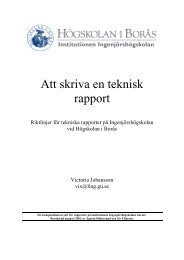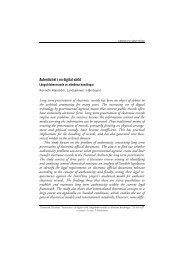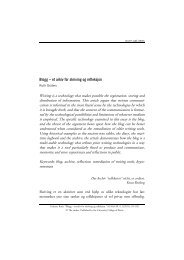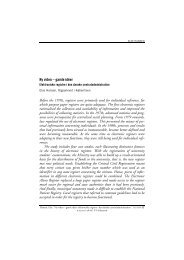The Challenge of Managing Affordances in Computer Game Play
The Challenge of Managing Affordances in Computer Game Play
The Challenge of Managing Affordances in Computer Game Play
Create successful ePaper yourself
Turn your PDF publications into a flip-book with our unique Google optimized e-Paper software.
HUMAN IT REFEREED SECTION<br />
and understood, and because they create cognitive affordances. For <strong>in</strong>stance,<br />
when count<strong>in</strong>g co<strong>in</strong>s, a person can keep track <strong>of</strong> the ones already<br />
counted by po<strong>in</strong>t<strong>in</strong>g, which <strong>of</strong>f-loads her cognitive processes and leads to<br />
more efficient performance <strong>of</strong> the task.<br />
As the player entered the room through the w<strong>in</strong>dow she had not planned<br />
how to get out, but now that she is done <strong>in</strong> there, she is try<strong>in</strong>g to figure a<br />
way out. Does she have to climb out the w<strong>in</strong>dow aga<strong>in</strong> or is there another<br />
way out? Instead <strong>of</strong> plann<strong>in</strong>g ahead, she uses cues <strong>in</strong> the environment<br />
which help her choose a strategy. She sees the door, which she th<strong>in</strong>ks is a<br />
possible way out, so the strategy she chooses is to try the door <strong>in</strong>stead <strong>of</strong> the<br />
w<strong>in</strong>dow. [ * ] She approaches the door and “bumps” <strong>in</strong>to it, not able to<br />
pass through. She thought <strong>of</strong> the object as “a way out”, only this time, her<br />
strategy actually did not lead to a more efficient performance.<br />
Yet another perspective on affordances is one that actually throws the<br />
concept right back <strong>in</strong>to the very dualistic <strong>in</strong>formation process<strong>in</strong>g view <strong>of</strong><br />
cognition that Gibson wanted to avoid <strong>in</strong> the first place. A good example<br />
is “honesty <strong>of</strong> affordances”, which means that “a tool tells the truth, the<br />
whole truth, and noth<strong>in</strong>g but the truth about the capabilities it has”<br />
(Fitzgerald & Goldste<strong>in</strong> 1999, 179). With reference to Gibson, Fitzgerald<br />
and Goldste<strong>in</strong> argue that the use <strong>of</strong> an object is determ<strong>in</strong>ed by its<br />
properties, and that a mapp<strong>in</strong>g between actual and perceived affordances<br />
is not enough. Instead, they emphasise the role <strong>of</strong> the designer who chooses<br />
which affordances a tool conveys. <strong>Affordances</strong> are seen as a means <strong>of</strong> communication<br />
between designer and user, and the underly<strong>in</strong>g idea is that<br />
the possible uses <strong>of</strong> a designed tool can be <strong>in</strong>tentionally communicated<br />
through its affordances. <strong>The</strong> general idea, then, is straightforward: “design<br />
th<strong>in</strong>gs so people can see what they are for”. It is also recognised <strong>in</strong><br />
this view that objects afford some capabilities due to social histories and<br />
conventions. Nevertheless, this approach resorts to a de-contextualised<br />
<strong>in</strong>formation-process<strong>in</strong>g view; it is assumed that ready-made knowledge<br />
can be “transferred” from a designer to a user, and it boils down to “add<strong>in</strong>g”<br />
the right affordances to a physical design. Not much left <strong>of</strong> a mutual<br />
agent-environment relationship there!<br />
94









